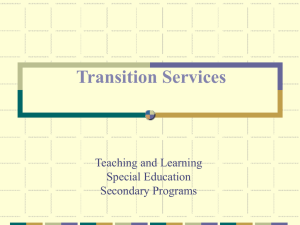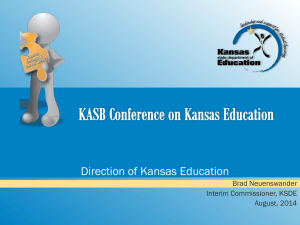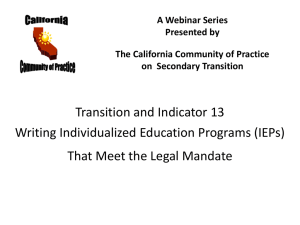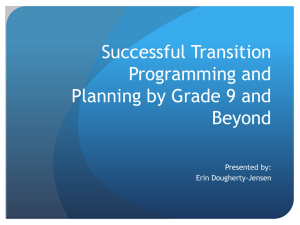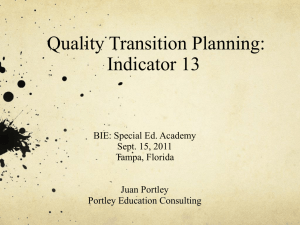Triangulation Workshop #3 Transition IEP: Building on
advertisement
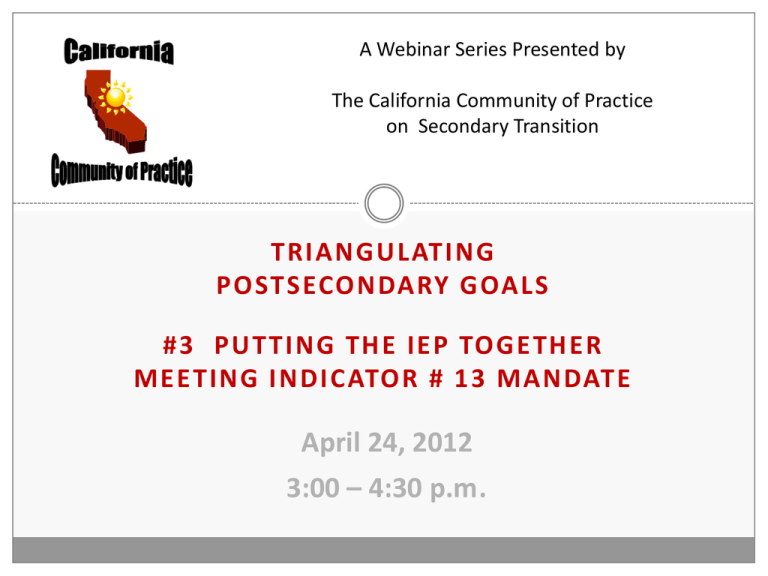
A Webinar Series Presented by The California Community of Practice on Secondary Transition TRIANGULATING POSTSECONDARY GOALS #3 PUT TING THE IEP TOGETHER MEETING INDICATOR # 13 MANDATE April 24, 2012 3:00 – 4:30 p.m. Welcome J I L L L A RS O N , CO O R D I N ATO R O F CO P C A L I F O R N I A D E PA RT M E N T O F E D U C AT I O N P R ES E N T E RS S U E SAW Y E R , C A T R A N S I T I O N A L L I A N C E LO N I A L L E N , PA R E N TS H E L P I N G PA R E N TS Goals Our goal has been to offer a series of webinars to improve writing transition goals in the IEP. Today we will Review the transition mandates in the IEP Explore the parent perspective on transition Explore developing annual transition goals by triangulating secondary goals, common core standards and industry standards Construct the IEP IDEA: Transition Focus: Improve academic and functional achievement to facilitate movement from school to post-school activities Based on youth’s strengths and interests Includes instruction, related services, community experience, development of employment and other post-school living objectives Mandates the development of a plan that summarizes skills, strengths, transition readiness, needs State Performance Plan Indicator 13 requires IEPs to: List measurable postsecondary goals in employment, education/training, and independent living, if needed Be updated annually Be based on age appropriate assessments List transition services Define the course of study State annual IEP goals related to postsecondary goals Invite students to the meeting Invite representatives of agencies that are approved by parents/students Timeline Based on Indicator 13, specific items need to be addressed before the meeting 1. Invitation to student to attend transition IEP. 2. Invitation to agencies (approved by parents/student) 3. Age and grade appropriate assessment During the meeting Develop the IEP List postsecondary/annual goals, services, course of student After the meeting: Implement the IEP Postsecondary Goal Mandates One goal in each area: Education or Training Employment Independent Living, if IEP team determines appropriate Goal statements - measurable outcomes Use action verbs Relevant Time frame (12-24 months after high school) Measurable Postsecondary Goals IDEA and the National Post-school Outcomes Center specify what areas postsecondary goals need to address. The language must be outcome focused. A best practice is to state the goal in the “I” voice. After high school _(I) (Name) will _____________________________________________________ __________________________ Behavior where/how Is it countable? Can it be answered with yes or no? Measurable Postsecondary Transition Goals IDEA defines post secondary education/training outcomes: Enroll in college or university Earn occupational certificate Enroll in vocational training (ROP, beauty school, pet grooming, trucking school, ……. ) Enter military for training in…. Enter an apprenticeship Complete on the job training Enter Community based training … May list major, industry, or job of interest as goals mature. Measurable Postsecondary Goals Employment Competitive work - full time / part time Supported employment Integrated work activity or Entrepreneurship Volunteer Measurable Postsecondary Transition Goals Independent Living Goals Live independently Live with family, roommates Live independently with supportive services Live in group home Manage finances, household Access community – independently, use public transportation Annual Goals Prepare annually for postsecondary goals Directly relate to education, employment and independent living goal statements How do we know the goals are reasonable and relevant? One way is to utilize industry standards, state common core standards, and identify the expectations of the “next environment” Triangulating Goals Postsecondary Goals Education/Training Employment Independent Living Annual Goals Industry Standards SCANS / 21st Century Skills Common Core Standards “Next Environment Prerequisites” Let’s Explore O’NET O’NET can inform the IEP Entry into careers require education and training O’NET information can help students Research Careers Complete on line applications Resumes for scanning Define postsecondary goals www.onetonline.org Industry Standards Inform the IEP Have you ever wondered what students need to know and do in various career areas? O’NET is the Occupation Information Network that is the national database for jobs in the U.S. It lists the Industry standards required for success in the student’s stated career interest area. It can be aligned with student assessments. We will explore how industry standards language can be integrated into the annual goal statement. Common Core State Standards (CCSS) Background: Common Core State Standards were a voluntary state led effort coordinated by the Council of Chief School Administrators and the National Governors Association Center for Best Practices. Standards were developed for math and English-language arts Goal: Develop a set of consistent, clear educational standards that would prepare students for college and career success Timeline: California adopted the standards August 2, 2010 and is working to develop curriculum, assessment and instructional materials. Key concepts of the Common Core State Standards A new way of thinking Universal Design for Learning Instruction Assessment Multiple pathways Learning progression Individualized and personalized Common Core State Standards Aligned with college and work expectations Prepare students for success in entry-level, credit bearing, academic college courses (2- and 4-year postsecondary institutions) Prepare students for success in careers that offer competitive livable salaries above the poverty line, opportunities for career advancement, and are in growing or sustainable industries Parents / Family Post-Secondary Support, Mentors Now Let’s Hear the Parent Perspective What needs to happen before the IEP Schedule, Invite students, parents, agencies, IEP team Assessment including parent input Loni Allen is here to share the parent perspective. Loni is a member of the Community of Practice Leadership Team and is with Parents Helping Parents. Some Common Issues for Parents Are: •Lack of training about transition rights •Lack of awareness of agencies who provide transition support or what programs are available •Anxiety about transition process •Concerns about employment or further education/training •Concern about independent living and if they may end up supporting the child into adulthood •Who will care for the child when the parents are gone •Concerns that the students postsecondary goals may not be realistic •Concerns about safety How can parents help? Offer input about the young person’s interests Participate collaboratively in the assessment and goal development process Provide personal networks to help a young person Partner with the school to effectively explore work-based learning outside of school settings Constructing the Transition IEP Postsecondary Goals Education, Employment, Independent living Annual Goals - lead to attainment of postsecondary goals Student Interests, Readiness, Challenges Core Academic Standards Industry Standards Course of Study Think about Casey . . . Casey is a very social 17-year-old junior. He is eligible for special education under specific learning disability. He maintains a “B” average, taking courses this block semester in Art, Algebra, World Studies, and co-taught English with a lot of special education support. He would like to become a fire fighter. His general interests are Realistic (based on the Holland Code). Assessments: Interest Surveys, Interviews, He wants to work part-time his last year in high school. Analyze: Which skills will have the greatest academic impact on future growth, success and transition to post secondary life? Casey’s Postsecondary Employment Goal: After high School, I will be employed as a forest firefighter O’NET: Tasks Collaborate with others as a member of the crew Extinguish flames and embers to suppress fires using shovels, pumps Test and maintain equipment, tools, jump gear, parachutes Maintain contact with fire dispatchers-notify them of needs for resources Rescue victims, administer emergency first aid Skills Active listening, speaking Coordinate actions with others, Monitor to make corrective actions Critical Thinking Abilities Oral Comprehension, Oral expression Problem sensitivity, Deductive reasoning Postsecondary Education Goal I will attend Shasta College to earn a fire technology certificate. Education: High School Diploma + Specialized training Annual Goal Language Triangulated goals require that there is an obvious connection between postsecondary goals and annual goals. Examples may include: In order to prepare to work as a firefighter, Casey will successfully complete ROP Fire technology. Casey will look for employment in a part-time job. Think about Kelly . . . Kelly is a junior with intellectual disabilities on a certificate track for graduation. She receives work training in a veterinary clinic, learning to use public transportation to/from work training and to use a visual/picture schedule to complete tasks. She is polite but has difficulty conversing/sharing information and /asking for assistance with coworkers/peers/teachers/supervisors. She would like to have a job working with animals. Assessment: Vocational Situational Assessment, Interest Survey, Interview Interests: realistic, conventional Analyze: Which skills will have the greatest academic impact on future growth, success and transition to post secondary life? Kelly’s Postsecondary Employment Goal: After high School, I will be employed as an animal caretaker My Next Move Summary (Based on O’NET) What they do: Feed, water, groom, bathe, exercise, or otherwise care for pets and other nonfarm animals, such as dogs, cats, ornamental fish or birds, zoo animals, and mice. Work in settings such as kennels, animal shelters, zoos, circuses, and aquariums. May keep records of feedings, treatments, and animals received or discharged. May clean, disinfect, and repair cages, pens, or fish tanks. Basic Skills keeping track of how well people and/or groups are doing in order to make improvements; listening to others, not interrupting, and asking good questions; Problem Solving noticing a problem and figuring out the best way to solve it Education: High School Diploma Specialized training/ OJT Postsecondary Education Goal I will complete specialized training through the Petco stylist apprentice program. Mapping Annual Transition Goals to Academic Standards Goal Tasks Exhibit Learner Outcome Academic Standards Submit error free job application online Research job opportunities Print out of job application for portfolio Student will apply skills to work settings. Read, interpret informational text. Read job announcement Complete accurately, and error free document. Submit on-line Gather relevant information. Write information clearly Demonstrate knowledge of standard English, vocabulary and spelling. Use technology Employment Age / Grade Appropriate Career Planning Create Actionable Plan Grade 12 Get Ready Advocate for services Tale Care of Self Identify job opportunities using Craig’s list, cal jobs, Complete classes to earn diploma/certificate Apply to Department of Rehabilitation for transition support. Research cost of living in your area using Reality Check Identify the postsecondary education/training program that will meet the educational needs, certification standards for your career. Submit online applications that provide you meet minimum qualifications. Complete career technical classes and/or elective classes that relate to your interests. Apply to Disability student programs and services at the community college. Develop a personal budget to meet your needs. Write resumes that demonstrate you have the skills, abilities and talents to be considered for employment. Demonstrate knowledge of career decision-making process. List Employment ADA rights List reasonable Accommodations Using Job Accommodation network. Pass placement tests and/or entry tests Grades 7-9 Find a Job Independent Living Skills Develop personal career / education plan Submit applications to postsecondary education or training programs Grades 10-11 Job Search Postsecondary Goal: Competitive Employment in a specific career What Do Students Need To Do? Career Preparation Self Advocacy State tentative career choice Research tentative career interests to identify industry or career opportunities that match your personality, interests, talents, skills and educational / training goals. Research career choices using O’NET and or California Career Zone to match yourself to career choices. Explore career choices through career fairs, education fairs, informational interview, job shadowing Apply for benefits if appropriate. Demonstrate self advocacy skills to advocate for yourself d the workplace. Interview for employment opportunities in careers of interest. Practice completing job applications and develop “cheat sheet” to ensure you have an error free sample application. Expand exhibits in your portfolio that you can share with potential employers. Participate in job fairs Develop mock applications Participate in mock interviews Develop resume, portfolio Review social media presence to verify that you are not disclosing a disability on line. Enroll in Career-Technical Classes and/or elective classes that relate to career interests. Participate in volunteering, service learning, internship, work experience or other Work based learning opportunities related to interests. Lead you own IEP Develop your portfolio that demonstrates your skills, Apply for financial aid Demonstrate the “soft skills” needed for education, training and independent living. Verify on line reputation is appropriate. Register to vote, Males, for draft Navigate a community Financial Literacy Self Care Community orientation Request accommodations as needed Develop recreation interests Health and Wellness Reflect on experiences to validate your interests. Identify career pathway courses offered at your school. Know learning style, Actively participate in IEP Explore odd jobs, volunteer options Connect hobbies, interests to general career choices Know yourself Connections Agencies What agencies that will provide post-school support are in your community? You are required to document an invitation, with parent/guardian/student approval. If it is not appropriate to invite an agency, list N/A and document. Community Experiences Does your student participate in community based experiences/activities? Youth groups, 4-H, arts programs, volunteer programs Special Olympics Course of Study High school graduation goal Diploma or Certificate District requirements /Graduation Status CTE / Elective classes related to career goals Other items to consider: Test Scores Academic History Attendance Behavior Postsecondary goals and prerequisites Course of Study When we discuss the course of study, it is important to look at the “next environment.” Do programs of interest have prerequisite testing? What are the qualifications? What do students need to know about the next environment? www.thinkcollege.net When I was researching training programs for animal care, I found this at Petco: http://careers.petco.com In Conclusion It is important to remember ….. Transition is a process, not a document The spirit of transition focuses on the youth The transition IEP can help the student understand the reason to complete classes, engage in their community and envision a future Transition Planning Begins with Student Choices When do we start to help them dream about their future? Hope Confidence Resources 35
